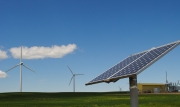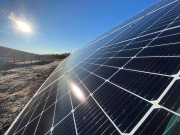I travelled to Germany at the end of March with a group of Canadians to learn about the country’s energiewende or “energy transition”. The energiewende has been a long-term effort in Germany to move from nuclear and fossil energy reliance to a renewable and alternative energy supply. The energiewende has been credited with driving innovation and demonstrating policy measures that can be effective in accelerating the worldwide deployment of renewable energy.
 Our group included representatives from federal and provincial governments, the renewable energy industry, academia, political parties and environmental non-governmental organizations (NGOs). It was a diverse and engaged group that the German government brought over to learn about the energiewende. We met with a similarly diverse set of representatives from German government departments, NGOs, consultancies, industries and civil society organizations. We quickly developed a reputation as a very curious group known for asking a lot of questions. But — given the remarkable circumstances of the across-the-spectrum coalition that has formed behind Germany’s visionary energy approach — I think we could be forgiven for our inquisitiveness!
Our group included representatives from federal and provincial governments, the renewable energy industry, academia, political parties and environmental non-governmental organizations (NGOs). It was a diverse and engaged group that the German government brought over to learn about the energiewende. We met with a similarly diverse set of representatives from German government departments, NGOs, consultancies, industries and civil society organizations. We quickly developed a reputation as a very curious group known for asking a lot of questions. But — given the remarkable circumstances of the across-the-spectrum coalition that has formed behind Germany’s visionary energy approach — I think we could be forgiven for our inquisitiveness!
The trip was fascinating. Seeing and experiencing things firsthand helped to debunk myths about the energiewende and the German electricity system. We also found a broad national consensus, built on the resolve that the difficulties of this energy transition should be treated as interesting challenges worthy of German ingenuity and determination.
Debunking myths
I landed in Germany on the first day of spring and immediately saw evidence of the mistruths perpetuated in our media about the country’s renewable energy effort. With winter’s end came proof that has defied speculation from the UK and North America that winter would bring doom and gloom for the continent’s power systems.
The naysayers suggested the switch to “greener sources of energy” would make blackouts rampant over the winter as it “complicates the balance of supply and demand in the region.” In fact, two of the most reliable grids in Europe are powered by Germany’s abundance of installed wind and solar and Denmark’s very high wind supply.
 Based on what one reads in North America, I was almost shocked to find that the locals still carry fully charged smart phones and — as far as I can tell — candle sales have not skyrocketed. Instead, I was present just in time to see the continent pull through the dark winter with its grid reliability intact.
Based on what one reads in North America, I was almost shocked to find that the locals still carry fully charged smart phones and — as far as I can tell — candle sales have not skyrocketed. Instead, I was present just in time to see the continent pull through the dark winter with its grid reliability intact.
My arrival also plunked me down in the middle of a solar eclipse that was said in early March to threaten to “shut down Europe.” Some of my local media played up anxieties about this perfectly predictable phenomenon, which ostensibly threatened to knock down the German electricity system’s house of cards. Indeed — right after I landed — I got texts from family concerned about blackouts threatening my trip.
The result? Mere energiewende fear mongering. Europe successfully kept the lights on while the moon put blinders on the sun. As one observer proclaimed, “Grid operators 1, solar eclipse 0.” The system delivered “rock-solid stability throughout the 2.5-hour eclipse.” Operators of systems with a high proportion of variable renewables are always balancing supply and demand in the face of weather changes — which are much less predictable when compared to the science of astronomy.
Vision required to hurdle obstacles
The German approach to its energiewende is impressive because it sees obstacles as challenges to overcome rather than walls to bang one’s head against. German officials acknowledged there have been challenges. Contracts for renewable energy were a tad too sweet after technology prices fell unexpectedly and contract rates weren’t revised quickly enough. Cap-and-trade carbon allocations in the European Trading System are too generous to industry, making it cheap to emit and too attractive to continue with coal power. There is also the drop in wholesale electric energy prices associated with increased renewable energy deployment — which we’ve described here in the Alberta context — and the impact on further investment decisions.
 The big lesson I took away from these conversations is this: the obstacles that come with shifting to a renewable and alternative energy supply are something to tackle. They are opportunities for leadership in advancing the world’s understanding of technical, engineering and policy solutions to the challenges posed by the clean energy transition.
The big lesson I took away from these conversations is this: the obstacles that come with shifting to a renewable and alternative energy supply are something to tackle. They are opportunities for leadership in advancing the world’s understanding of technical, engineering and policy solutions to the challenges posed by the clean energy transition.
There are similarities between Germany and Alberta’s electricity systems. It’s imperative to transition from the energy sources we currently rely on — coal in both jurisdictions as well as nuclear in Germany. The difference is, German leadership has come not because they’re doing everything right or because they have better renewable energy options (they certainly don’t!) but because of their resolve to choose a path toward cleaner energy production and to see that path through twists, turns and some hard slogging. They have built confidence through experience that, despite the challenges, the lights will stay on and power bills will get paid while they continue to move forward with persistence and ambition.









